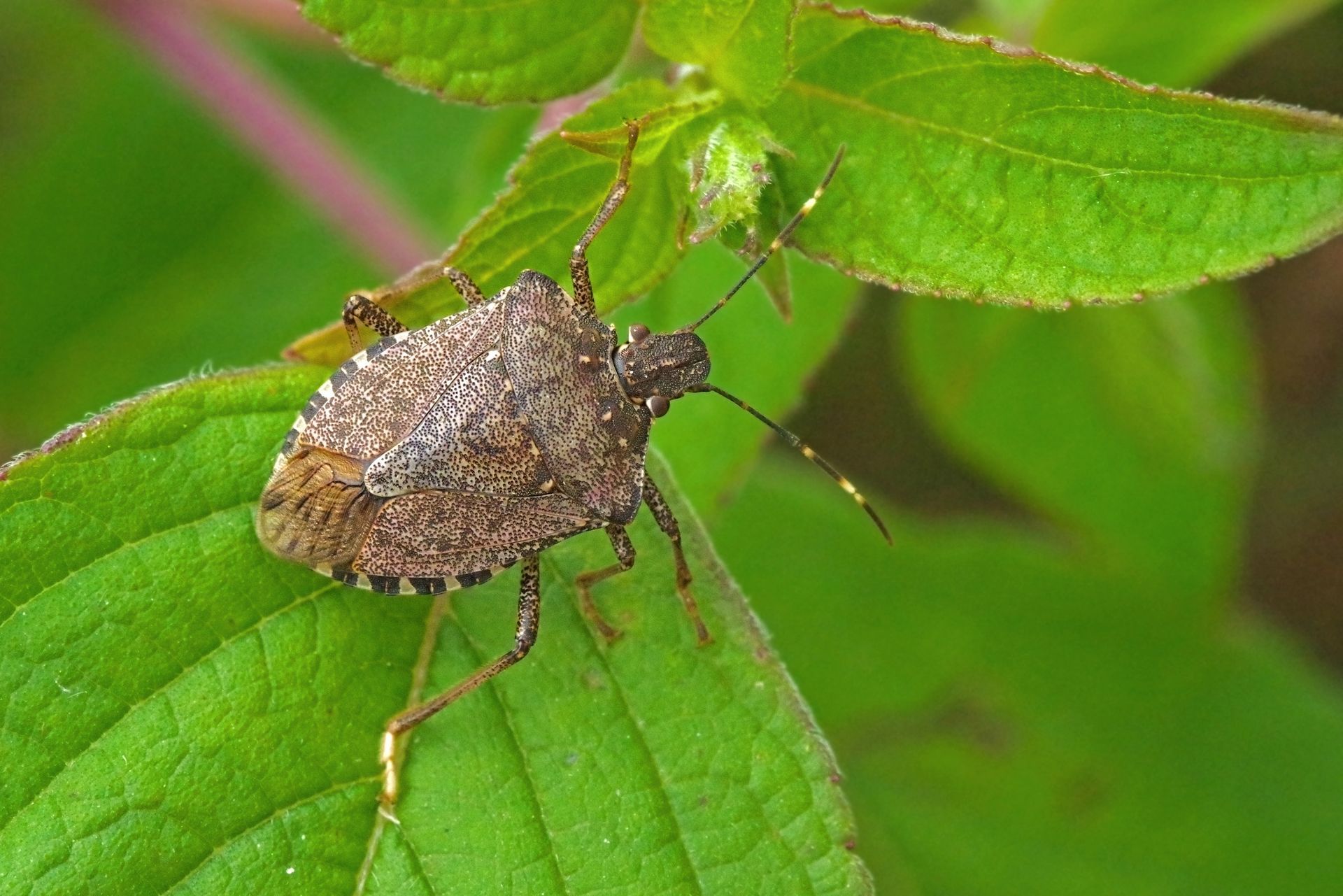What Are Stink Bugs? Stink Bug Facts & Information

There are over 5000 species of stink bugs that exist around the world but the most commonly known species in the United States are brown marmorated stink bugs. This species is native to Asia but was introduced to the US back in the 1990’s where it was first found in Pennsylvania. Since then, it has become an invasive species that spread south and westward and can now be found all over the US. Stink bugs are notorious for the foul odor they release when threatened and are identified by the shield shaped back that is covered in marbled markings.
Stink Bug Identification
Stink bugs have six legs and a wide shield shaped body that resembles an upside-down triangle. Their bodies are covered in a marbled pattern that is made of grey and brown spots. They’re about a ½ to ¾ inch long and nearly as wide. Their legs extend past their bodies making them appear wider than they actually are. Adult stink bugs have fully developed wings that allow them to fly but these wings don’t develop until they have reached maturity.
Why Do Stink Bugs Stink?
Stink bugs produce chemicals inside their bodies that they can release as a defense mechanism to deter potential predators. These chemicals when released give off a foul odor that is offensive to predators like birds, fish, and reptiles who have sensitive noses. These chemicals are produced by glands on the sides of the stink bugs body where it pools inside of small holes called evapatoriums. These evapatoriums serve the purpose of helping to release the scent faster so it can be an effective deterrent.
Stink Bug Diet
The different species of stink bugs can be classified into herbivorous and predatory stink bugs.
Herbivorous stink bugs are primarily agricultural pests that feed on plants, fruits and vegetables. They use their mouthparts to pierce the delicate plant membranes before sucking out the juices inside of the plant or fruit. Since stink bugs gather in large numbers, infestations can wreak havoc on gardens, orchards, and vineyards where stink bugs will consume everything in their path. Stink bugs are particularly fond of fruit trees where they can feast on peaches, apples, pears, and tree nuts. Stink bugs feed on major agricultural crops like tomatoes, soybeans, and corn as well. Stink bugs will drain these fruits and vegetables of their juices which cause damage to the skin making these damaged goods impossible to sell.
Predatory stink bugs on the other hand, are known to feed on other garden variety bugs including other stink bugs. Since these stink bugs primarily feed on other agricultural pests, predatory stink bugs are considered beneficial insects.
Are Stink Bugs an Agricultural Threat?
Stink bugs are considered an agricultural threat due to the damage large numbers of stink bugs can have on harvests. It is estimated that stinkbugs cause millions of dollars in damage to crop harvests every year. Since they feed on a wide variety of plants, there aren’t too many plants that are safe from stink bug infestations. As of now, there are currently over 175 different important crops that stink bugs are known to target. These include:
- Fruit crops: apples, pears, cherries, grapes, berries, peaches, apricots, plums, figs, citrus
- Vegetable crops: corn, peppers, leafy greens, peas, tomatoes, beans, okra, eggplant
- Staple crops: soybeans, sorghum, sunflowers
The threat that stink bugs pose is exacerbated by the fact that they are an invasive species that has no natural predators that keep their populations under control.
Why Do Stink Bugs End Up Inside?
Stink bugs are an outdoor pests for most of the year but once temperatures start to cool off, they will start to prepare to overwinter somewhere warm. This often results in stink bugs moving indoors in large numbers. The reason they collect in large numbers is due to aggregation pheromones they release that attract other stink bugs once somewhere safe has been discovered. Once inside, the stink bugs will enter a dormant period called diapause while they wait out the winter. During this time, the stink bugs are mostly inactive and not feeding or mating. Once temperatures start to rise, the stink bugs will become more active in their search to return outside.
Stink Bug Reproduction & Life Cycle
Every year, adult stink bugs will overwinter somewhere safe before emerging in late spring to feast for the first time in months. After feeding for 2 weeks, stink bugs will have the energy to mate and produce a brood of eggs. Eggs are typically laid between May and August on the underside of leaves in clusters of up to 400 eggs at a time. These eggs take up to a week to hatch before the nymphs emerge. Newly hatched nymphs will need to pass through 5 instar stages before the reach maturity. Each instar stage takes about a week and requires the nymph to molt. The final molt will result in a fully developed stink bug. The adult stink bugs will have fully developed wings that they will use to find a new place to overwinter before the cycle starts again. In regions that don’t get cold enough for overwintering, stink bugs will just continue to breed all year round, producing up to 3 broods every year.
Do Stink Bugs Bite?
Stink bugs do not have the right body parts to cause painful bites or stings. Normally, when insects bite or sting, it is to help defend themselves or feed. Stink bugs do not have the correct mouth parts to bite or chew. Instead, their mouths are made up of a long tube-like proboscis that remains tucked under their body when it is not being used to drain the juice out of their target food sources. When it comes to defense, stink bugs primarily rely on their foul odor to act as a defense mechanism to deter any predators.
Signs of Stink Bugs
Stink bugs in small numbers normally don’t present too much of a problem so small infestations can go unnoticed for some time. It is important to know what the signs of a stink bug infestation are so you can catch the problem when it first emerges. The most common signs of stink bugs include:
- Live stink bugs aggregating on crops
- Clusters of eggs found attached to the underside of leaves
- Bruising or other skin damage found on fruits, vegetables, and leaves
- Foul odor that smells like cilantro
How to Get Rid of Stink Bugs
Normally the best way to get rid of an insect is to eliminate the things that attract them in the first place. However, since stink bugs are attracted to fruits and vegetables, it isn’t feasible to eliminate gardens, orchards, or vineyards where stink bugs are most likely to be found. Instead, it is important to monitor these areas for stink bugs so you can identify a stink bug problem as soon as it starts. When stink bugs are found outside, the best way to get rid of them is using insecticidal soaps and oils to spray down infested plants. This should help eliminate any stink bugs that become problematic. If they end up finding their way inside a home once temperatures drop, then it is best to use a vacuum cleaner to trap the bugs before they are discarded. Be sure to seal them inside of the vacuum bag or drown them so they are unable to return.
Once they have been removed, it is important to implement exclusion tactics to prevent future stink bugs from returning. Exclusion strategies include sealing entry points like cracks in the foundation, repairing torn window screens, and installing door sweeps. If all other measures fail, it may help to hire on professional pest control experts to help get rid of stink bugs.
Contact EcoGuard if You Are Dealing with Stink Bugs
If you are dealing with a large-scale stink bug infestation, professional pest control experts can take care of your problem. EcoGuard Pest Management has a team of licensed and experienced stink bug control experts ready to come inspect your property and treat problematic areas. Our services are designed to safely and effectively exterminate your stink bug problems and prevent them from coming back. Call today to schedule an inspection.

















